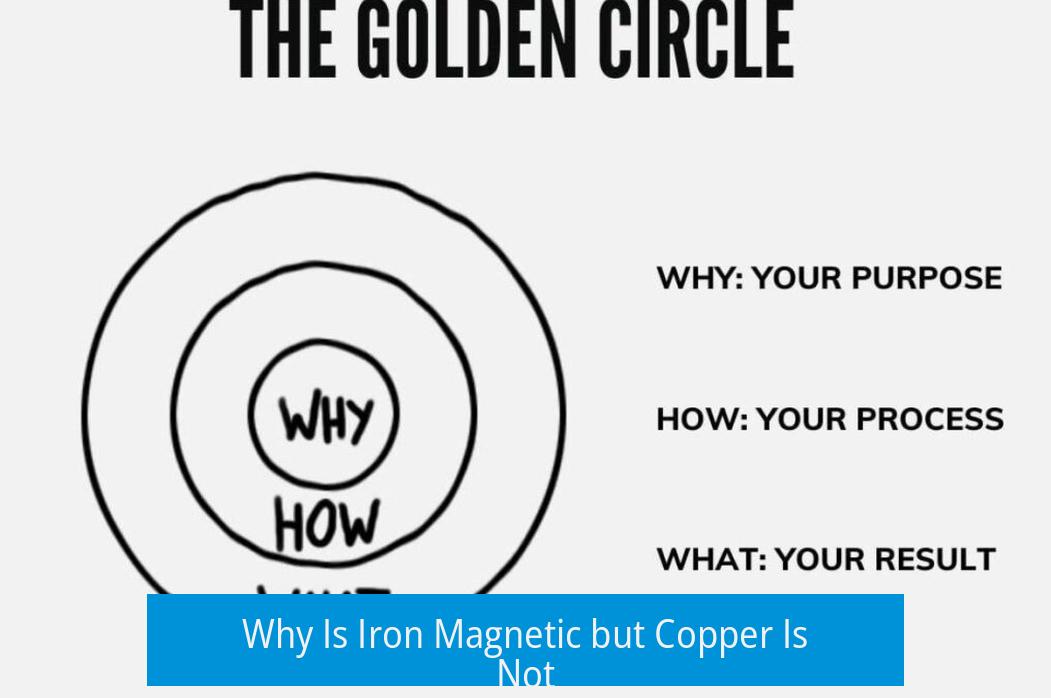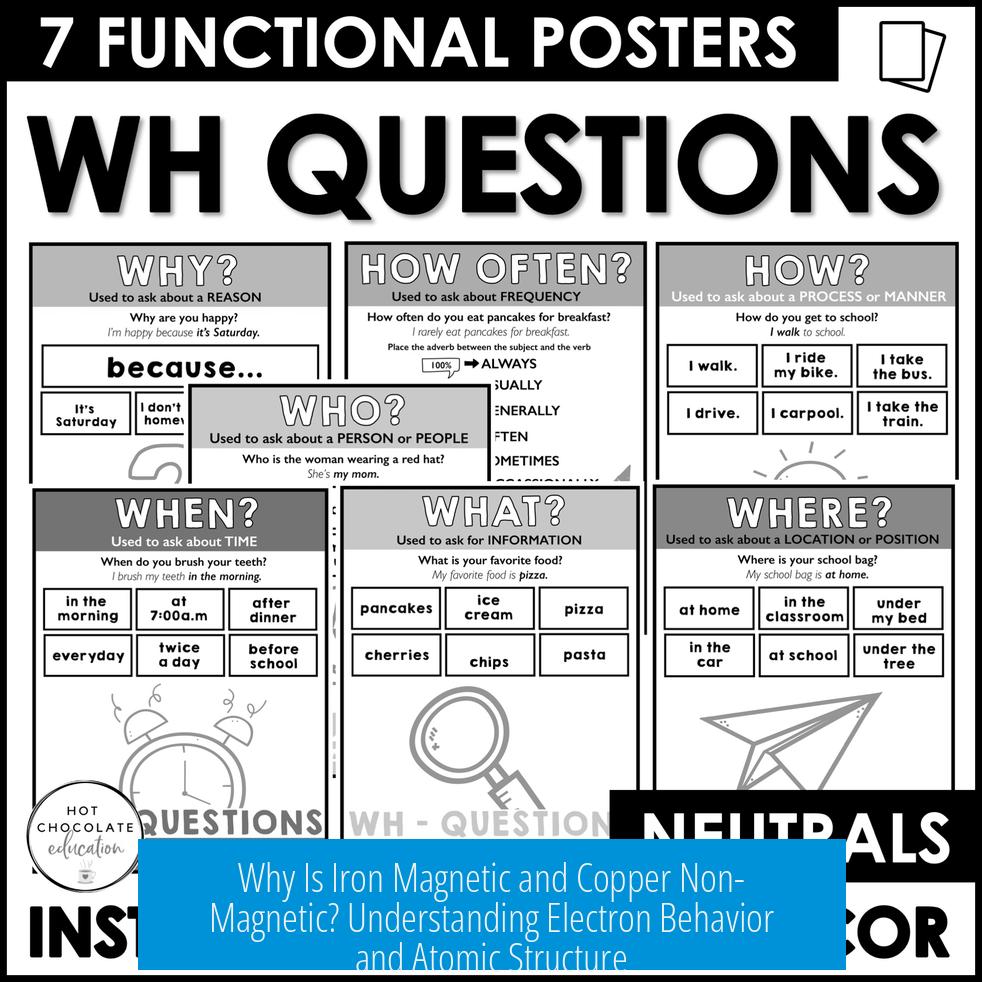Why Is Iron Magnetic but Copper Is Not?

Iron is magnetic because it contains unpaired electrons in its atomic structure that can align their spins to create a magnetic field, while copper’s electrons are mostly paired, preventing such alignment and resulting in no inherent magnetism.
Electron Configuration and Its Role in Magnetism

Magnetism in materials primarily depends on the presence of unpaired electrons in their atomic or molecular structure. Iron, with 26 electrons, exhibits several unpaired electrons in its valence shell. These unpaired electrons have parallel spins that generate tiny magnetic moments.
In contrast, copper has 29 electrons with almost all of its electrons paired in orbitals. The paired electrons have opposite spins, which causes their magnetic effects to cancel each other out.
- Iron’s unpaired electrons: found in 3d orbitals, allow spin alignment.
- Copper’s configuration: 3d orbitals are full, 4s has one electron, but overall electrons are paired.
- Only unpaired electrons contribute to magnetism in solids.
This difference in electron configuration is fundamental. Iron atoms can generate magnetic moments, while copper atoms cannot generate a net magnetic moment under ordinary conditions.
Ferromagnetism and Electron Spin Alignment
Besides having unpaired electrons, a material must allow these magnetic moments to align across atoms to be strongly magnetic. This phenomenon is known as ferromagnetism.
In iron, unpaired electrons experience an interaction called exchange coupling, which causes their spins to align parallel in domains. This results in a macroscopic magnetic field.
- Unpaired electrons feel spin directions of neighbors.
- Alignment is energetically favorable and stabilizes the magnetic order.
- Temperature affects alignment; high heat disrupts magnetic order.
Copper does not show ferromagnetism because it lacks the necessary unpaired electrons and favorable interactions. Hence, it cannot sustain aligned spin domains.
Comparison: Iron’s Ferromagnetism vs. Copper’s Diamagnetism
Both iron and copper respond to magnetic fields, but in different ways:
| Property | Iron | Copper |
|---|---|---|
| Magnetic Type | Ferromagnetic (strong, permanent magnetism) | Diamagnetic (weakly repelled by magnetic fields) |
| Electron Configuration | 4 unpaired electrons in 3d shell | Mostly paired electrons; filled 3d shell |
| Spin Alignment | Parallel spins align to create domains | No spontaneous spin alignment |
Iron’s ferromagnetism allows it to become a permanent magnet. Copper’s diamagnetic nature means it weakly repels magnetic fields but does not sustain magnetism itself.
Electron Density and Band Structure Explaining Magnetism
The advanced understanding of magnetism involves examining electron bands and their density near the Fermi level (the highest occupied energy state at absolute zero).
In iron, the density of states at the Fermi level favors ferromagnetic coupling. This means electrons tend to align spins rather than pairing oppositely.
Most metals, including copper, have electronic structures where antiferromagnetic (opposite spin) pairing is preferred or no net alignment emerges.
Thus, the band structure of iron enables the stabilization of aligned spins, promoting strong magnetization.
Magnetism Beyond Electron Spin
Magnetism arises not only from electron spins but also from the movement and relative motion of electric charges creating magnetic fields.
Paired electrons generate opposing magnetic effects that cancel out. The unpaired electron’s motion about the atomic nucleus contributes to the net magnetic moment.
Copper can exhibit magnetism under special conditions, such as when carrying an electric current, due to moving charges producing magnetic fields. However, in its natural state, copper shows no intrinsic magnetic order.
Atomic Structure’s Central Role in Magnetic Properties
Ultimately, the atomic electron arrangement governs magnetic properties. Iron has unpaired electrons arranged to enable magnetic moment alignment and ferromagnetic behavior.
Copper’s electrons are paired, which restricts the formation of a net magnetic moment. Therefore, copper does not become magnetic in isolation.
It is noteworthy that not all metals are magnetic, and the presence of electrons alone does not determine magnetism.
The specific electron arrangements, interactions, and solid-state effects define whether a material is magnetic.
Summary of Reasons Why Iron Is Magnetic but Copper Is Not
- Unpaired Electrons: Iron has multiple unpaired electrons; copper has mostly paired electrons.
- Spin Alignment: Iron’s electrons align spins via ferromagnetism; copper lacks this ability.
- Electronic Band Structure: Iron’s density of states favors ferromagnetic coupling; copper does not.
- Atomic Magnetic Moments: Iron’s atomic moments reinforce; copper’s cancel out.
- Magnetic Classification: Iron is ferromagnetic; copper is diamagnetic.
Key Takeaways
- Unpaired electrons create magnetic moments; iron’s configuration yields several, copper’s does not.
- Ferromagnetism requires aligned electron spins across atoms; iron exhibits this, copper does not.
- The electron density near the Fermi level in iron stabilizes magnetic order.
- Magnetism arises from more than just spin—movement of electric fields also matters.
- Copper’s paired electrons and atomic structure cause it to be non-magnetic under normal conditions.
Why is Iron Magnetic but Copper is Not?
Short answer: Iron is magnetic because it has unpaired electrons that align their spins in the same direction, creating a magnetic field; copper, on the other hand, mostly has paired electrons whose spins cancel each other, so it doesn’t exhibit magnetism.
Now, let’s dig deeper into this magnetic mystery and reveal why iron loves to stick to your fridge, but copper just sits there quietly, admiring the action.
Unpaired Electrons: The Spark of Magnetism
Imagine electrons as tiny spinning tops orbiting the nucleus of an atom. These spins create tiny magnetic fields. The magic happens when you have unpaired electrons—in other words, electrons with no buddy spinning opposite to them. Iron is like that popular kid at school who has lots of unpaired electrons (six out of 26 electrons are unpaired!). They team up and spin in harmony, generating a strong, collective magnetic field.
Copper, however, plays it safe. Out of its 29 electrons, they prefer to pair up—two in each orbital—so their spins cancel out. It does have one electron in the 4s orbital flying solo, but that’s not enough to turn copper into a magnetic superstar. It’s like having just one dancer alone on the floor; it’s hard to put on a show.
Ferromagnetism: When Spins Get Together
Now, just having unpaired electrons isn’t the whole story. These electrons need to “talk” to each other, aligning their spins collectively. This phenomenon is called ferromagnetism. Iron nails this perfectly because the unpaired electrons can sense their neighbors and energetically prefer to sync their spins in one direction—think of it like synchronized swimming but on an electron scale.
Copper falls short here. Its electronic structure doesn’t support this cooperative behavior. The single unpaired electron is a lone wolf, and the rest are paired, so copper’s spins don’t form that unified alignment, leaving it diamagnetic, producing only a weak magnetic response that is easily overridden by other forces.
The Role of Temperature and Atomic Arrangement
Even iron’s magnetic magic can fail—turn up the heat! At temperatures above about 770°C (the Curie temperature), iron’s ferromagnetic behavior disappears. The thermal energy scrambles the electron spins, and the magnetic alignment falls apart. Copper, by contrast, remains unaligned at all temperatures; no unpaired electron marching orders here.
Besides temperature, the spatial arrangement of atoms also matters. Spacing too wide or misaligned atoms reduce the likelihood of spin coupling. Iron’s crystal lattice arrangement supports ferromagnetism beautifully, while copper’s does not.
The Deep Physics: Electronic Structure and Density of States
If you like complex science, here comes a bonus layer. Magnetism ties closely to something called the density of states near the Fermi level—the energy threshold where electrons can move freely.
In iron, the density of states at this level favors ferromagnetic coupling, making it energetically cheaper for spins to align rather than oppose. Copper’s electronic band structure lacks this property. Its electrons tend to pair up with opposite spins (antiferromagnetic pairing), resulting in no net magnetic moment.
So, behind the scenes, it’s a quantum dance of electrons following the laws of band theory. Not something copper’s electrons want to join.
Magnetism Beyond Electron Spins: The Electric Field Tango
You might think that magnetism springs directly from electron spins, but it’s actually the relative motion of electric fields that creates magnetic effects. Unpaired spins are a handy shortcut for remembering this, but the true source is electromagnetic motion.
Paired electrons, spinning opposite ways, create opposite electric field motions that cancel their magnetic effects. Copper’s paired electrons cancel out any magnetic force those lone dancers could produce.
Fun fact: Copper is magnetic when it carries an electric current. Running electrons through copper wires generates a magnetic field as moving charges create changing electric fields. But in its natural, resting state? Copper is as magnetic as your coffee mug—none at all.
Practical Takeaways and Fun Comparisons
- Magnets:** Iron’s magnetic properties make it perfect for cores in transformers and motors.
- Copper conductivity and magnetism:** Copper is widely used for electrical wiring because it’s an excellent conductor, not because it’s magnetic. When current runs through, it briefly becomes magnetic.
- Everyday example:** You can pick up a magnet and attract iron nails or paperclips. Try it with copper coins—they won’t stick unless the magnet is REALLY strong, and even then, it’s just a weak force.
Here’s an easy challenge: next time you see a coin or a metal object, think about its electron arrangement. Iron? Lots of unpaired electronics rocking the spin party. Copper? All paired up, choosing peace over magnetism.
Final Thoughts
Iron captivates us with its strong magnetism because it masters the electron spin game. Unpaired electrons align perfectly to summon ferromagnetism. Copper, elegant but reserved, prefers paired electrons and quietly stays diamagnetic until current sets it in motion.
Understanding this difference illuminates not only basic chemistry but also the engineering marvels that power electronics and magnetic devices daily. Iron teaches us that a little alignment goes a long way, while copper reminds us that perfection lies in pairs.
Next time you hold a magnet, ask yourself: is it dancing with iron or just passing by copper? The answer spins on electrons.
Why does iron have unpaired electrons while copper mostly has paired electrons?
Iron’s electron configuration includes several unpaired electrons in its outer shells. Copper’s electrons are mostly paired, which cancels out magnetic effects. This difference causes iron to be magnetic and copper not.
How does electron spin alignment create ferromagnetism in iron?
Ferromagnetism happens when unpaired electrons in neighboring iron atoms align their spins in the same direction. This spin alignment generates a strong magnetic field. Copper lacks this alignment, so it doesn’t show ferromagnetism.
Is copper completely non-magnetic or does it show some magnetic behavior?
Copper is diamagnetic, meaning it weakly repels magnetic fields due to paired electrons. It is not ferromagnetic like iron. However, copper can exhibit magnetism when carrying an electric current.
Why can’t copper atoms’ electrons align to form a magnetic field like iron?
In copper, all electrons are paired, so their magnetic effects cancel out. Without unpaired electrons to align, copper atoms cannot produce a lasting magnetic field like iron can.
Does temperature affect the magnetic properties of iron?
Yes, high temperatures can disrupt the alignment of electron spins in iron. When iron gets too hot, electron spins become randomized and lose their magnetic order, reducing its magnetism.





Leave a Comment